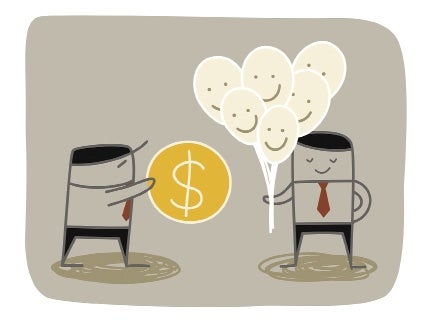On the surface, the question, “Hard sell or soft sell?” may seem like a no-brainer, so let’s define them. Hard sell is not about hammering someone into doing something that isn’t right for him. I’m referring to being direct and getting the prospect involved in what he needs, cutting through fear, denial and other roadblocks.
Meanwhile, soft sell is not about using touchy-feely language and letting the prospect control the process. Rather, it’s about listening with empathy and understanding your prospect and his needs.
Keeping those definitions in mind, there’s a fine line between the two, and you need to learn when to cross it. The problem with most salespeople is that they’re either hard sell or soft sell, or iron fist or velvet glove, not both. You need to be able to use both approaches and know when to use each one.
Here are the rules for hard sell versus soft sell.
When to use hard sell and soft sell
As a general rule, you want to be soft at the beginning of the relationship. When you’re getting to know the prospect and building rapport, you want to be soft, slow and listen a lot. Once you have a full understanding of the prospect’s needs, it’s time to be direct and make sure he gets it. At this point, you need to cut through everything else and push, if necessary, to get to the sale.
The type of person you’re dealing with will also dictate whether you’re hard sell or soft sell and when to cross that line. With a hard-nosed, straightforward individual, you’ll go from soft sell to hard sell faster than you will with someone who’s more laid-back, easygoing and slower in his approach.
In some cases, you never need to cross the line. You’ll have a great connection with certain people who will see the opportunity and know what they have to do. So you’ll be able to lead them directly down the path toward the sale.
Following up
Another area affected by selling style is follow-up. Most “soft sell” people will follow up once or twice, if at all. If you only follow up once or twice, you won’t make the sale in most cases because the average sale happens after the fifth contact. On the other hand, most “hard sell” people tend to follow up too much and too early. This will irritate most everyone and make selling more difficult.
All things considered, it’s better to follow up too early and too often and to push a bit too much rather than not enough. The salesperson who recently called me seven times in seven days made a sale, while the person who only followed up once didn’t, even though I wanted his product more. And I think I’m probably like most buyers.
Play both sides
The bottom line: To be the best possible salesperson, you have to develop both the hard and soft side of your approach. As with every other area in selling, only by practicing will you get good at using both approaches and knowing when to use one over the other. n
John Chapin is a sales motivational speaker and trainer based in Auburn. Contact him at johnchapin@completeselling.com.

